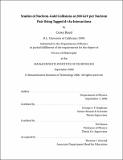| dc.contributor.advisor | George S.F. Stephans and Wit Busza. | en_US |
| dc.contributor.author | Reed, Corey (Corey James) | en_US |
| dc.contributor.other | Massachusetts Institute of Technology. Dept. of Physics. | en_US |
| dc.date.accessioned | 2007-11-15T21:34:54Z | |
| dc.date.available | 2007-11-15T21:34:54Z | |
| dc.date.copyright | 2006 | en_US |
| dc.date.issued | 2006 | en_US |
| dc.identifier.uri | http://hdl.handle.net/1721.1/39484 | |
| dc.description | Thesis (Ph. D.)--Massachusetts Institute of Technology, Dept. of Physics, 2006. | en_US |
| dc.description | This electronic version was submitted by the student author. The certified thesis is available in the Institute Archives and Special Collections. | en_US |
| dc.description | Includes bibliographical references (p. 201-212). | en_US |
| dc.description.abstract | The spectra of charged hadrons produced near mid-rapidity in d+Au, p+Au and n+Au collisions at - = 200 GeV are presented as a function of transverse momentum and centrality. These measurements were performed using the PHOBOS detector at the Relativistic Heavy Ion Collider (RHIC). Nucleon-nucleus interactions were extracted from the d+Au data by identifying the deuteron spectators. The deuteron spectators were measured using two calorimeters; one that detected forward-going single neutrons and a newly installed calorimeter that detected forward-going single protons. The large suppression of high-pr hadron production in central Au+Au interactions relative to a naive superposition of p+p collisions has been interpreted as evidence of partonic energy loss in a dense medium. This interpretation is founded upon the absence of such suppression in the yield of d+Au collisions. The validity of using d+Au interactions in place of a nucleon-nucleus reference is tested. It is shown that hadron production in d+Au agrees with a simple binary collision scaling of hadron production in p+Au. An ideal reference for Au+Au collisions is constructed using a weighted combination of p+Au and n+Au yields and is found to be similar to the d+Au reference. | en_US |
| dc.description.abstract | (cont.) Further, hadron production in p+Au interactions is compared to that of n+Au interactions. The single charge difference between a p+Au and a n+Au collision allows for a unique study of the ability of the interaction to transport the proton from the initial deuteron to mid-rapidity. However, no asymmetry between the positively and negatively charged hadron spectra of p+Au and n+Au interactions is observed at (qr) = 0.8. Collision centrality was determined using several different observables, including those based on the multiplicity in different regions of pseudorapidity and those based on the amount of nuclear spectator material. It is shown that measurements made on small collision systems in the mid-rapidity region are biased by centrality variables based on the mid-rapidity multiplicity. Despite this bias, a smooth evolution with centrality is observed in the Cronin enhancement of hadrons produced in d+Au collisions. It is shown that this smooth progression is independent of the choice of centrality variable when centrality is parametrized by the multiplicity measured near mid-rapidity. | en_US |
| dc.description.statementofresponsibility | by Corey Reed. | en_US |
| dc.format.extent | 215 p. | en_US |
| dc.language.iso | eng | en_US |
| dc.publisher | Massachusetts Institute of Technology | en_US |
| dc.rights | M.I.T. theses are protected by copyright. They may be viewed from this source for any purpose, but reproduction or distribution in any format is prohibited without written permission. See provided URL for inquiries about permission. | en_US |
| dc.rights.uri | http://dspace.mit.edu/handle/1721.1/7582 | |
| dc.subject | Physics. | en_US |
| dc.title | Studies of nucleon-gold collisions at 200 GeV per nucleon pair using tagged d+Au interactions | en_US |
| dc.type | Thesis | en_US |
| dc.description.degree | Ph.D. | en_US |
| dc.contributor.department | Massachusetts Institute of Technology. Department of Physics | |
| dc.identifier.oclc | 174255405 | en_US |
